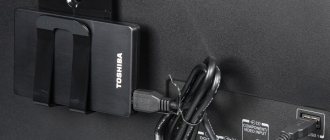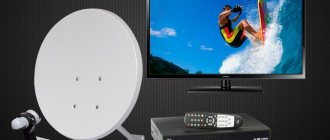Agree, sometimes when using programs on laptops that require a large working space that a standard screen cannot provide, it is much more convenient to use a modern television panel as a monitor. In this regard, there is an urgent need to solve the problem when you need to connect a TV to a laptop via a VGA output. Why VGA? Because almost all models of laptops and TVs are equipped with such connectors. But when creating such a connection, in some cases you may encounter some difficulties. Next we will show how to bypass or eliminate them, as well as make the correct connection and initial setup of both devices.
How to connect a TV to a laptop via VGA: what will you need?
The first step is to make sure that there are appropriate connectors on both devices. Of course, when connecting devices to each other, it is advisable to use outputs and inputs of the same name. There are no problems here.
But you can often encounter a situation where the laptop only has a VGA output (aka D-Sub), and the TV only has an HDMI connector. Here the essence of the question of how to connect a TV to a laptop via VGA-HDMI is to use a special adapter.
Problems when connecting a laptop to a TV via HDMI and VGA:
By connecting the laptop to the TV using wires, using HDMI or VGA adapters or adapters. You may be disappointed with the image quality.
No signal from laptop to TV:
If you do not have a signal, try pressing the Windows keys (with the flag logo) + P (Latin) and select “ Expand ”. Perhaps the image will appear.
And if you have Windows 7, then right-click on the desktop. Go to Display Settings and try to identify the second monitor and also set it to Extend.
When connecting a laptop to a TV via HDMI, there is no sound, but there is a picture:
If you have an image but no sound and you are using an HDMI cable without adapters, then:
- Right-click on the speaker icon next to the clock in the right corner.
- Select " Playback Devices ".
- Right-click on an empty space and turn on Show Disabled and Disconnected Devices . If there is an HDMI device in the list (there may be more than one). Right-click on the one you want and set “ Use as default ”.
How to connect a laptop to a TV using HDMI
Note: if you use a VGA -> HDMI adapter, the sound will not be transmitted. Since VGA does not transmit sound !
If there are no HDMI devices in the list, then you need to go to “ Device Manager ”. In the “ Sound, Game and Video Devices” section (and they are also missing in the sound adapters section in the device manager), it is quite possible that you do not have all the necessary drivers installed for your laptop’s motherboard or video card; you should take them from the official website laptop manufacturer (for a discrete video card - from its manufacturer’s website).
How to connect a laptop to a TV using HDMI
Problems with cables and adapters when connecting
Very often the TV does not work because of the VGA-HDMI cable, about 90%. And in general, such cables don’t really work. In most cases and for most laptops, such a cable will never work; you need a converter from analog to digital signal (or vice versa, depending on what is connected to what). It is only suitable for cases when the laptop specifically supports digital output via VGA, and this almost never happens.
VGA connection problems
But the problems don't stop there. This is due to the fact that only the picture is transmitted through VGA, but not sound.
But many would like to use the powerful acoustic systems of modern TV panels with multi-channel sound. How to connect a TV to a laptop via VGA so that there is also sound?
In such a situation, you will have to purchase a special VGA to HDMI adapter model, which additionally has connectors for audio transmission (either a regular 3.5 mm mini-jack or standard “tulips”).
Wired connection of a laptop to a TV via VGA
Do not miss:
- How to choose a projector for your home to connect to a computer, smartphone,…
- How to connect a second monitor or TV to a computer or laptop
- All about how to connect an LG TV to a computer, the Internet via...
If one of the devices does not have an HDMI connector, then you can think about how to connect your laptop to your TV via VGA. This is another connector that is often found in computer technology. It should be noted that in modern LCD TVs VGA is present less and less often. You should also be aware that VGA transmits pictures, but not sound. That is, the sound will have to be transmitted to the TV or speakers using some other cable.
First, you should get hold of a VGA cable. It can be easily found in any store that sells computer components. The cost of such cords is usually half that of the cheapest HDMI cable. The problem may arise if you need a very long wire - it is much more difficult to find one.
If the VGA socket is only present on the laptop (or only on the TV), then you will have to go for an active adapter. Such a device converts an analog signal to a digital one, or does it in the opposite direction. You should look for it in the same store that sells computer equipment. Chinese online stores can also help - AliExpress, GearBest and the like. Some models are additionally equipped with a 3.5 mm audio jack, which accepts audio in addition to video.
When you have the necessary cable and (if necessary) an active adapter, all that remains is to insert the plugs into the appropriate sockets. Next, press the “Input” button on the remote control - a list of available signal sources will be displayed on the TV screen. Select the connector to which the cable or adapter is currently connected.
Windows second screen settings
Read more about Windows settings in the article “How to connect a second monitor or TV to a computer or laptop“
If everything is done correctly, the laptop desktop will be displayed on the TV screen. However, the screen aspect ratio may be distorted. If this is the case, then go to your laptop and right-click on a free area of the desktop. In the context menu, select “Screen Resolution”. Here you need to select the name of your TV in the drop-down list. Next, in the “Resolution” section, select the parameter that is the maximum allowed for the TV screen. In a word, make sure that the picture does not stretch or shrink.
Even lower in the menu that opens, you can find the “Multiple Screens” item. Here you can choose exactly how the picture will be displayed. That is, the following options are available:
- The picture is simply duplicated;
- The TV becomes a second desktop, expanding the first;
- The picture is only displayed on a laptop;
- The image is shown only on the TV.
The most relevant option is the fourth option, so that the laptop does not waste extra energy on displaying the picture. When you disconnect the VGA cable, the image will return to the laptop screen.
How to connect a laptop to a TV via DLNA
There is another way to connect a laptop to a TV. It consists in creating a DLNA server. However, this way you will not be able to display your desktop on the TV screen or watch YouTube this way.
Instead, the TV will detect those media files that are stored in the computer's memory, becoming able to play them. That is, in this way you can watch videos and photos, as well as listen to music - as long as it is all stored on the hard drive located inside the laptop.
Please note that not all TVs can connect to a laptop in this way. DLNA technology is understood by absolutely all devices that support Smart TV. If the TV is not “smart”, then check it for DLNA support in the technical specifications indicated on the manufacturer’s website. And don’t forget that connecting to DLNA is possible both via Wi-Fi and via a network cable (in this case, an Ethernet connector is used).
So, how to connect a laptop to a TV via Wi-Fi?
To do this you will have to organize a DLNA server. This cannot be done only within the Windows 7 Home Basic operating system. Starting with the “Home Extended” version, this feature is present, not to mention the “eights” and “tens”. How is this done?
You should start by visiting the Control Panel. Here you should go to the “Home Group” section. You can also get to this section as follows: right-click on the notification icon in the notification area, then select “Network and Sharing Center”, and in the menu that opens, click on “Home Group”.
You are now in a window where you can configure homegroup permissions. Here you should click on the “Create Home Group” button. The corresponding wizard will open immediately. Click the “Next” button, then specify the types of files to which remote access will be provided. This could be videos, images, music, documents, and even a printer. Click the "Next" button again.
At this stage, the system will generate a password that will be needed to connect to the homegroup. This password can be changed in the future. And after clicking the “Done” button, you will be taken to the HomeGroup settings window. Everything here is left to your discretion.
In particular, we recommend changing the name of the home group, as well as creating a memorable password. But most importantly: check the box next to “Allow all devices on this network, such as TVs and game consoles, to play shared content.” It is after checking this box that a full-fledged DLNA server will be created.
In general, the setup is complete. From now on, you can access multimedia data from any device on the same Wi-Fi network - even from a tablet or smartphone.
How can I access videos and music from my TV?
It all depends on the device manufacturer and the specific model. Some use the SmartShare application, other models use AllShare. Be that as it may, you need to find the “Local Network” item - that’s where you will find the name of the DLNA server you created earlier. Of course, don't forget to connect to Wi-Fi if you haven't already. Of course, the laptop must be connected to the same network. However, this option is also possible when the laptop is connected to the router by wire.
An interesting way to connect to a DLNA server is to use a power outlet. To do this, you need to buy so-called Powerline devices produced by many network equipment manufacturers. Such devices are inserted into sockets, after which all that remains is to insert the plugs of the TV and router into them.
In an application that supports DLNA, you will not see the usual file system. Instead, all media content will be divided into photos, music and videos. Next, you can choose different types of sorting. There is nothing complicated about this; there is no point in talking about this process in all the details.
It is not necessary to connect to the router using Wi-Fi. If the TV is located close to it, then you can use a network cable. This will have a positive effect on the data transfer speed, as a result of which you will be able to play videos with a very high bitrate.
Frequently asked questions
How to connect a laptop via cable without straining?
The easiest way to do this is with an HDMI cable. The other methods, which are also discussed above, are still a little more complicated.
Is it possible to connect more than just a TV to a laptop via DLNA?
Yes, the DLNA server will be visible to everyone on your home Wi-Fi network. For example, a smartphone can get access to media data - all you need to do is download a suitable file manager or VLC Player.
What to do if your TV does not connect to your home network?
Check to see if it even has this option. The absence of such is evidenced by the fact that the TV does not have a built-in Wi-Fi module and an Ethernet connector. If there is support for wireless networks, then try typing the password again - it is possible that you made a mistake last time. An even simpler method of connecting to a router is to use the WPS button. However, budget routers are deprived of it. It would also be a good idea to read the operating instructions that came with the TV.
What is the best way to connect a laptop to a TV: wired or wireless?
Of course, connecting via HDMI is simplified to the extreme, so this method may seem like the best way. But we must not forget that a high-quality HDMI cable costs money. You should not buy a cheap wire, as soon it may simply fail.
If you don’t want to spend money, then it’s better to use a wireless connection by creating a DLNA server. But on Windows 10 you can do without this by using a proprietary application from the TV manufacturer. Of course, this will only work if Smart TV is supported. Unfortunately, the cheapest TVs, lacking an operating system, are left behind - they can only be connected to a laptop using a cable.
What exactly do you need to connect to a laptop for?
This question is akin to a philosophical one. Displaying images on a TV screen is necessary for more comfortable viewing, because a laptop is limited to 13-15 inches, while a television display is much larger. And if the laptop is very powerful, then the TV can be used as a second monitor - this simplifies the work when editing videos and editing photos.
Initial screen setup
The TV is connected to the laptop via VGA-HDMI. Now you should check your screen mirroring settings.
You may initially need to specify the connection type on the TV panel by selecting HDMI as the source by pressing the Source (Input) button on the remote control several times or by calling up the appropriate menu. On some models of television panels, you may need to enable or disable the TV/AV or TV/Video modes (it all depends solely on the modification of the TV and its manufacturer).
After this, to connect the TV to the laptop via VGA, you need to send the image to the television panel. As a rule, one of the function buttons F1-F12 should have a special icon with two screens. The button is used in combination with the Fn key, although there is no uniform standard among manufacturers. Typically, a single press causes the image to appear on the TV, and a second press returns the image to the laptop screen.
However, there is a universal solution on all Windows systems. It is enough to use the combination Win + P, after which a setup menu will appear, including expanding the screen to multiple monitors or duplicating it. In Windows 10, this function is available by clicking on the notification icon in the system tray at the bottom right. In addition, if the automatic setting of screen parameters does not work, you will need to set the resolution on the TV directly in Windows manually, based on its characteristics and capabilities.
Alternative Image Adjustment Method
But, let’s say, using this method, the TV did not connect to the laptop via VGA, or the combination did not work for some reason.
As a backup option, you can use RMB on a free area of the “Desktop” and select the screen resolution setting. In the basic settings, you can perform the same operations (extend the screen onto two monitors or duplicate it, depending on the user’s needs). For example, when expanding, you can display only the media player on the TV panel, but when duplicating, you can display the entire space of the “Desktop” or a running program.
Types of connectors and cables
Typically, a large monitor is connected to a laptop through one of 3 connectors:
- VGA
- DVI
- HDMI
For example, below shows the presence of a VGA connector on a laptop and on a monitor, through which both gadgets are connected with a cable:
What cable is needed for connection? Depending on the selected connector, this may be VGA, DVI or HDMI cables.
Most often it is recommended to use HDMI. However, you may have an older model laptop that only has a VGA port. As for DVI, it is not available on all models.
You can also connect your monitor to your laptop using DisplayPort. This is a relatively new interface, usually found in premium laptops. The connector is similar to HDMI, but not completely - the cables for connection are different. If you have such a port on your laptop, then use it, since this is, in fact, a “pumped up” version of HDMI.
There is also a way to connect a monitor to a laptop via its USB port, but we will talk about this below. For now, let’s demonstrate what all the listed connectors and cables to them look like:
Below are a few important nuances related to the presence/absence of certain ports.
- The laptop only has DVI and VGA - use DVI by connecting it to the HDMI port of the monitor via an adapter
- There is no HDMI on the monitor, what should I do? Also use an adapter - but this time HDMI - DVI
- On a laptop HDMI, and on a VGA and DVI monitor - similarly (see above)
Why is it better to use HDMI and, if the first option is not available, then DVI? The fact is that the VGA input is analog and does not provide a good quality picture.
As you already understood, if the inputs are different here and there, then you need to use adapters that can be purchased at any electronics store - just a competently knowledgeable seller. For example, this is what HDMI-DVI adapter cables look like.
Accordingly, there are adapters: HDMI-DisplayPort, HDMI-DVI, DVI-VGA, HDMI-VGA, which you can easily find in online stores or in regular electronics supermarkets.
So, the “priority” ports:
- HDMI (we put it first because it is most common)
- Display Port
- DVI
- VGA
ATTENTION!
When connecting via cable, the monitor and laptop must be disconnected from the power supply!
As soon as you have successfully “connected” them, the picture from your laptop’s desktop will immediately appear on the monitor (after loading the operating system).
Once again, under no circumstances should you connect the cable “hot”! Otherwise, what awaits you in the near future is not a comfortable job behind a wide monitor, but a search for finances for equipment repairs.
Sound settings
As it turns out, connecting a TV to a laptop via a VGA connector is only half the battle. Now you will have to start setting up the sound, since for some reason Windows systems do not automatically switch to television panels.
You can set the sound parameters through the RMB menu on the volume icon in the system tray, where the line of playback devices is selected. In principle, settings can be accessed from the standard “Control Panel”.
Here, on the playback tab, you should pay attention to the device that has HDMI in its name. Right-clicking opens a submenu, and in it selects the default device usage line. If the TV panel's audio system is not in the list, you should activate the display of disabled devices in the menu that is called up, and then repeat the steps described above.
As for switching the sound format, it all depends on the capabilities of the speaker system of the TV itself. On some models, right on the remote control you can find a special button that changes the sound, activating various audio circuits, setting the priority sound of different speakers, adjusting the equalizer, if provided, etc.
How to connect a laptop to a TV:
Connecting a laptop to a TV via HDMI:
How to connect a laptop to a TV using HDMI
Nowadays, all laptops have HDMI inputs. B = accordingly, all TVs also have HDMI inputs. Sometimes you will need HDMI to VGA adapters. But this is only if the laptop or TV connectors do not match. I would like to note right away that ordinary wires with different connectors at the ends most often do not work. Don't throw money away on any consumer goods.
HDMI is the best solution for connecting a laptop to a TV:
- HDMI is an interface that supports high quality digital resolution, as well as FullHD 1080p
- Also, not only the image, but also the sound is transmitted through the HDMI cable. (If this is not required, you can turn it off)
How to connect a laptop to a TV using HDMI
Connecting a laptop and TV is not at all difficult. You need to take a wire and connect one end to the laptop and the other to the TV. Next, on the TV remote control, most often use the SOURCE button to select the appropriate connection.
How to connect a laptop to a TV using HDMI
Next you need to make some minor Windows settings on your laptop:
How to connect a laptop to a TV using HDMI
On a laptop with Windows 7 or 8, you need to right-click on the desktop and go to the “ Screen Resolution ” menu. In the list of displays you will see the second device, this is a TV. Click on the big screen and change the settings:
If you wish, you can read the article How to Adjust Sound
- Resolution: the optimal one is automatically determined, but you can choose it yourself.
- Multiple Displays: Here we choose how the TV will work with the laptop. " Extend Screens " This laptop is an extension of the TV. “ Duplicate Screens ” The TV screen shows the same as the laptop screen. “ Show on 1 ” the second one is disabled. The numbers are written on the screens in the display options.
Also, when connecting a laptop to a TV using HDMI, you will most likely need to adjust the sound. In order to configure the sound, right-click on the speaker icon in the Windows notification area (in the lower right corner where the clock is) and select “ Playback Devices ”.
How to connect a laptop to a TV using HDMI
In the list of audio devices, you will see a TV that matches the HDMI audio output. It must be designated as the default device. Right-click on it and select “ Set as Default ”.
Also on laptops there are special function keys and are designated Fn. And in the top row in the buttons from F1 to F12 there may be a key to enable output to an external screen. In my case, TV. (It happens that the key does not work, which means not all drivers are present in the system).
How to connect a laptop to a TV using HDMI
These keys are absolutely easy to identify; they are labeled as in the image above. And in Windows 8 and Windows 10, you can enable output to an external TV screen using the Win+P keys.










